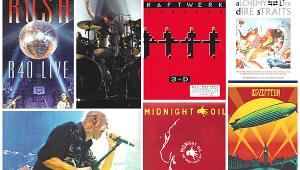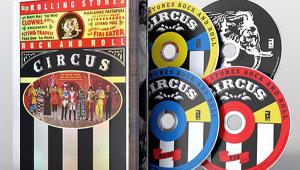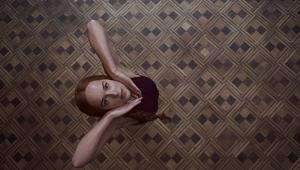The Future of Surround Sound Page 2
The Matrix
Before we can talk about what makes Atmos new, we should talk about where we are now. Surround sound in theaters is hardly a recent development. Decades of advances have led to most theaters featuring a multispeaker installation, usually with either 5.1 or 7.1 channels. “Multispeaker” here is an important distinction. Unlike in the home, where each audio channel gets its own dedicated speaker, theaters use multiple speakers per channel to effectively spread the surround effect across the entire seating area in large theaters.
A typical high-end theater will have speakers located behind the screen and evenly spaced along the side and rear walls. In a Dolby 5.1 configuration, there will be a “rear right” channel that will activate the right wall speakers and half the rear wall, and a “rear left” channel, which will do the opposite side. With 7.1, sound designers get two more channels to play with. Now each portion of the back wall can be separate from the side walls and from each other.
The additional channels in a 7.1 system allow for better steering of effects. Think of each channel as a zone. A designer can mix a sound to a zone, their imagination limited only by the number of zones available. With just a mono surround channel, sounds can fly out of the screen and go behind you to a single rear zone, but that’s it. With 5.1, you have two rear zones, which means sounds can whiz past you to one side. And with 7.1, there are four rear zones, so sounds can move cleanly from the sides of the room to the rear.
The problem with each of these setups is that there’s a limit to how smoothly a sound can move from zone to zone. There will be audible gaps in a sound that moves from the speakers behind the screen to the side speakers. And even with the best possible mixing, the movement of sound from the side speakers to the rear ones will still be somewhat clunky.
Atmos improves upon this situation by making each speaker in a theater its own zone, with pinpoint accuracy down to a few feet. Instead of 5.1 or 7.1 channels, with multiple speakers used to create large zones, Atmos currently allows for up to 64 individual speaker feeds, and small, precise zones. With Atmos, panning sounds move almost seamlessly from speaker to speaker, instead of from large area to large area. Think of it as adding resolution to the physical reproduction of sound: Where 5.1 is more realistic than 4.0, and 7.1 more so than 5.1, Atmos leaps past a simple increase of a few channels to achieve something greater.
Sure, if you’re using the older “channel” label, Atmos could be considered a 61.3-channel format, but that’s not entirely accurate. Atmos is scalable, from stereo all the way up to 61.3 — and theoretically even beyond.
The traditional method for mixing movie soundtracks involves sending sounds to specific channels. Dialogue, for example, goes to the center channel, and music, usually, to the left and right channels. Certain special effects and ambient sounds might go in the surround channels. Sitting at a mixing board (or, more likely, a computer), the sound mixer directs all the sounds in a film to each of the 5.1, 7.1, or however many channels they want for a final mix. A similar process happens when remixing the movie soundtrack for the Blu-ray release.
The problem with this method is that for every variation of theater, there has to be a separate mix. You can’t use a 7.1 mix for a stereo-equipped theater, just as you wouldn’t want to use a stereo mix for a 7.1 theater. Not, that is, if you wanted to take advantage of all the speakers. It’s a time-consuming process. For the most part, you need to remix the movie multiple times to create a stereo mix and however many different multichannel mixes you want.
With Atmos, there’s only one mix. That’s because with Atmos, sounds aren’t mixed to specific channels; instead, they’re sent to different areas. So, instead of mixing a sound to the “rear right” channel, it’s sent to the back corner of the room. That may seem like a subtle distinction, but the results are significant. When the Atmos mix is played at the theater, an Atmos renderer decides what sound to send where, based on the dynamic locations programmed in the audio file and the number of physical speakers available to convey it. So the single mix works, regardless of the number of channels.
To give a specific example of how this works, a slamming door sound that might have previously been routed to an entire rear corner of a theater (“rear right” channel) could be assigned to a specific speaker, precisely where the sound designer or mixer wants it to emanate from. Knowing what it has to work with inside that particular theater, the Atmos decoder decides which speaker will convey the sound. In a huge theater, it could send the sound to Speaker No. 12 of the 15 speakers along the right wall. In another theater, it could be Speaker No. 8 of the 9 speakers on the right wall. In its switch from a channel-based strategy to a location-based one, Atmos leaves behind any consideration of X number of channels, and simply uses what’s available.
The actual process of Atmos mixing isn’t radically different from how it’s currently done. On the sound designer/mixer side, Atmos is a simple plug-in to the industry near-standard ProTools software. A wire diagram of a room allows the mixer/designer to drag a “sound object” in a 3D space. What’s a “sound object?” It can be anything: a door slam, a cricket chirp, the zooming airplane mentioned earlier. Up to 128 different objects can be used at once, zooming and panning, appearing and fading.
Not every sound effect needs (or, in reality, uses) such specific placement, so Atmos allows for “beds” in addition to objects. A bed is a group of sounds that work together but are constrained to a typical channel layout (5.1, 7,1, 9.1, etc.). One example Dolby uses to explain the concept is a jungle scene. The sound of myriad animals and ambient jungle noises comes across as more realistic when spread across multiple speakers, so grouping them in beds allows those sounds to be distributed like a traditional rear-channel mix.
On top of these multisound beds (each counting as a track in the overall Atmos mix), the mixer can add objects on top with specific locations. It’s like building a collage of sound using the many tracks and channels available.
- Log in or register to post comments




























































